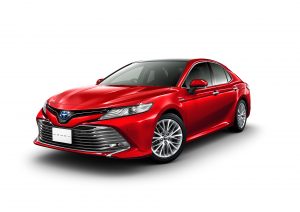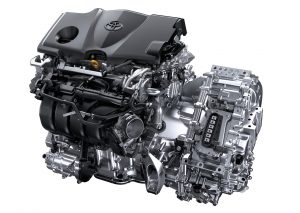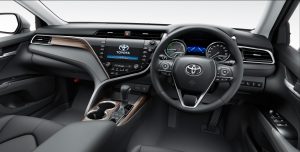On July 10, at the beginning of what seemed to be a dry rainy season, the press conference for the New Camry was held at the Mega WEB in Odaiba. The Camry, a front-wheel driven upper mid-sized sedan known for as the overwhelming best seller in North America, has undergone a full model change from the 9th generation, since it debuted 6 years ago.
The Camry, which is now in its 10th generation, adopts TNGA (Toyota New Global Architecture) indicating this is an all-new car from Toyota. Other models that have adopted the TNGA platform include the PRIUS and C-HR. But the new Camry was the first time it was redesigned all in accordance with TNGA.
It features a stunning design and a driving experience with good on-road ride quality, excellent mileage from the class leader, while giving an emotional drive. With the new Camry, Toyota hope for “the restoration” of the shrinking four-door sedan market.

 The new Camry is equipped with a newly developed 2.5 ℓ inline 4 cylinder engine and power unit combining THS II (Toyota Hybrid System Ⅱ). High-efficiency intake port A25A-FXS engine incorporating the latest mechanism such as direct injection injector newly developed with the high intake port. The combination of the two achieve a maximum compression efficiency / long stroke maximum thermal efficiency of 41%. The result is a maximum output of 155 kW (211 PS). It combines high efficiency and performance at high level. The fuel economy claimed at 33.4 km/ℓ.
The new Camry is equipped with a newly developed 2.5 ℓ inline 4 cylinder engine and power unit combining THS II (Toyota Hybrid System Ⅱ). High-efficiency intake port A25A-FXS engine incorporating the latest mechanism such as direct injection injector newly developed with the high intake port. The combination of the two achieve a maximum compression efficiency / long stroke maximum thermal efficiency of 41%. The result is a maximum output of 155 kW (211 PS). It combines high efficiency and performance at high level. The fuel economy claimed at 33.4 km/ℓ.
 (2,5 L A25A-FXS Engine)
(2,5 L A25A-FXS Engine)
The suspension is McPherson strut at the front and double wishbone at the rear. Rack parallel type electric power steering is adopted for the steering, to give a direct driving responses and a high-quality ride. Interestingly, the front struts are tilted backward towards the vehicle center, but this was a trial that aimed at optimizing geometry such as caster angles, but as a result, shortened the suspension stroke. It had been set to the top of the cylinder low, as a result of creating a flowing body line by lowering the hood.
Body size is total length = 4885 mm × full width = 1840 mm × total height = 1445 mm. Compared with the predecessor model, the total length and the whole width have been somewhat expanded, with total height lowered by 25 mm. Coupled with the built-in design, the more presence of the car is more impressive.
Vehicle weight is 1540 ~ 1600 kg, depending on the grade, is almost the same as the previous generation. Despite growing in size, the Camry has undergone substantial weight reduction. Due to the large size, Toyota had to adopt laser screw welding (LSW = technology to shorten the welding interval compared with conventional spot welding using laser) and expanding the site of adopting ultra-high tensile steel sheet. This resulted in the body rigidity strengthening despite the increase in size.
In addition, by looking in detail and arranging fine irregularities called ‘aero stabilizing fins’ and vortex generators on various parts of the body and the upper part of the door mirror, it improves aerodynamic performance. The result of this is improved fuel economy and reduction in wind noise to make it quieter inside the cabin to immerse yourself in.

